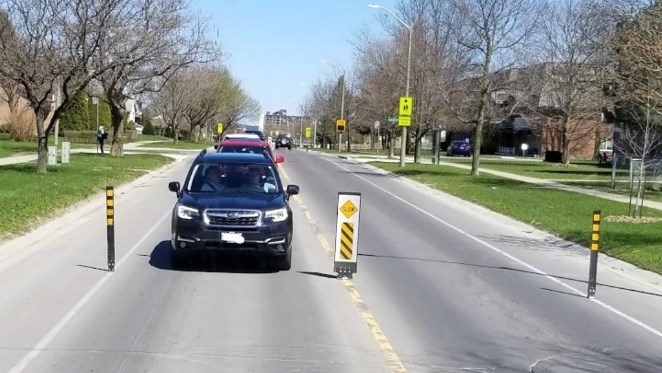With dozens of city streets looking for traffic calming – and a budget that allows just one road to be completed each year – Greater Sudbury is looking at temporary measures, city councillors heard Monday.
Traffic calming measures are aimed at reducing speeds on (usually) residential streets, and can include speed bumps and humps and concrete islands, all of which physically change the nature of the road.
While effective – the average speed on Attlee Avenue, for example, dropped from 50 to 46 km/h after traffic calming – the measures are sometimes unpopular, and the city has developed a consultation plan with residents to ensure they are in favour.
But with a budget of $165,000, just one project can be completed each year, while there are 31 streets on the list waiting to be done.
“If you're 30th on the list, it can be disconcerting,” Joe Rocca, the city's traffic and asset management supervisor, told the operations committee Monday.
What other cities have done – and Greater Sudbury is set to follow suit – is install “temporary flexible bollards,” Rocca said.
The bollards are flexible plastic posts inserted into the middle and sides of the street every 100-125 metres. They are removed each fall and have been shown to slow traffic by as much as 10 km/h.
A two-year pilot project will see them installed on Riverside Drive and Michelle Drive at a cost of $25,000. At the end of each year, staff will study the impact of the bollards and report back to council.
While approving the plan, Ward 12 Coun. Joscelyne Landry-Altmann wondered why the bollards are coming out before a report on whether reducing speed limits to 40 km/h would be effective.
“Why not do that (reduce speeds) first and then see what else is needed?” Landry-Altmann asked. “By lowering the speed limit, we will see a difference.”
Tony Cecutti, the city's GM of infrastructure, said the two issues are separate. While speed limits require police enforcement to be effective, traffic calming changes the nature of the road and requires drivers to slow down as a result.
“Those two issues are distinct and should be viewed separately,” he said. “These sticks in the road could be a reasonable interim approach.”
The bollards also give residents a chance to see the effects of traffic calming before permanent measures are put in place.
In the past, specific traffic calming measures have proven unpopular on streets such as Southview Drive, leading the city to spend more money making changes.
And the low cost allows them to potentially address most of the roads on the list at least temporarily, if the pilot project is successful.
“They might be there for 15 or 20 years, so I guess it's semi-permanent,” Cecutti said.
And Rocca said the staffer working on the report looking into lower speed limits is on leave, so it has been delayed until August.
The committee rejected another proposal that would lower the threshold for adding a street to the list. Currently, at least 50 per cent of residents on a road have to respond to opinion surveys on whether a neighbourhood wants traffic calming, and at least 60 per cent have to be in favour.
Rocca said several other other cities they checked with have lowered the response rate to 25 per cent for the initial survey. He said the switch would allow staff to plan educational meetings with residents to explain what they have in mind for the road, at which point support often increases.
“This change would allow us to move more projects to the next stage – developing a plan with residents,” he said. “But we still want to ensure there is strong support for traffic calming.”
But Ward 4 Coun. Geoff McCausland said lowering the bar that much raises concerns that staff would be using resources to plan for calming measures in areas that don't support them.
“I have to agree,” Landry-Altmann said. “The people that are so supportive of getting it done, they need to speak to other people on the street.”
And Ward 10 Coun. Fern Cormier – who said he gets complaints about speeding in residential areas “all day, every day” — also opposed the switch, and said the city should do a better job of communicating what's needed to get on the list.
“When we go to the neighbourhood, we have make it clear there is a threshold that must be met,” Cormier said.
But he liked the bollard idea as a means to offer temporary relief in a way the city can afford.
“I'm glad we're looking outside the box and we aren't afraid to get creative,” he said.
See the full 31-street list of roads approved for traffic calming here.
